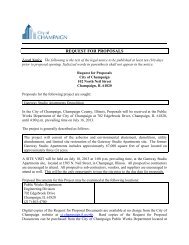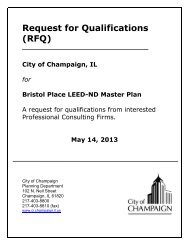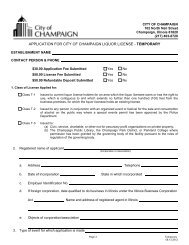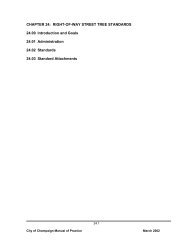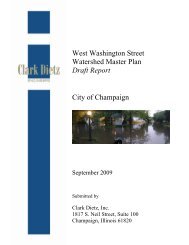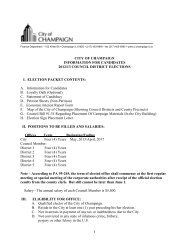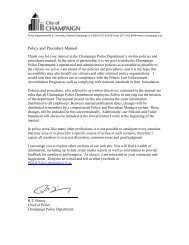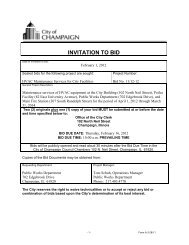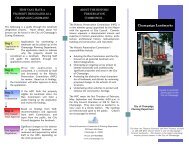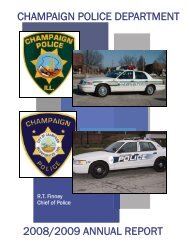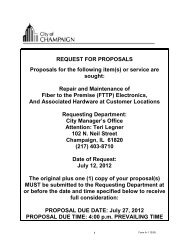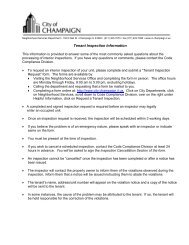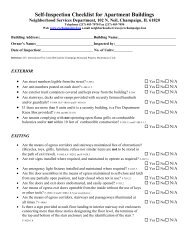2010-2014 Consolidated Plan - City of Champaign
2010-2014 Consolidated Plan - City of Champaign
2010-2014 Consolidated Plan - City of Champaign
You also want an ePaper? Increase the reach of your titles
YUMPU automatically turns print PDFs into web optimized ePapers that Google loves.
Due to limited incomes, many disabled households also find it very difficult to move from renting tohomeownership. <strong>City</strong> staff members are participating in an effort coordinated by PACE to enhanceopportunities for homeownership. The program provides down payment subsidies to qualified buyersplus education in the areas <strong>of</strong> household finances, home maintenance, and accessibility issues. Otherprograms like this are needed to assist the disabled population move to homeownership and achievelong-term financial stability.Another problem for the disabled is finding housing that is accessible. PACE maintains a list <strong>of</strong> accessiblerental units so that persons with mobility limitations can be linked to the few accessible units that areavailable. However, more accessible units, for both owners and renters, are needed to meet theincreasing demand.Builders are just beginning to understand and respond to the need for housing units that fit individualswith a variety <strong>of</strong> physical characteristics and mobility needs. Universal design principles are beingadopted in some municipalities across the country. These principles allow for the use <strong>of</strong> housing by allpersons, to the greatest extent possible, without the need for adaptation or specialized design. Inuniversal design, homes are built with features that are usable by people at all stages <strong>of</strong> life, at little orno extra cost. These features include no-step entries, open floor plans, accessible baths, and easy tooperate fixtures and hardware. (A full listing <strong>of</strong> univeral home design features is provided in AppendixC.)Although the use <strong>of</strong> universal design can be <strong>of</strong> great benefit to individuals with disabilities, it <strong>of</strong>tenbenefits others as well. For example, no-step entries and wider doorways benefit individuals usingwalkers and wheelchairs, as well as those carrying groceries or pushing strollers. Lowered peepholesallow persons in wheelchairs to view visitors, while also serving as a safety feature for households withchildren. Persons recovering from injuries will find it easier to maneuver in a home built with functionalaccessibility in mind. Likewise, aging in one’s own home is much more practical in a unit built touniversal design standards.The <strong>City</strong> <strong>of</strong> <strong>Champaign</strong> has adopted a set <strong>of</strong> visitability standards, which employ design criteria that aresimilar to universal design but more limited in scope. At this time, all single-family housing that isconstructed in accordance with strategies included in this <strong>Consolidated</strong> <strong>Plan</strong> (and accompanying AnnualAction <strong>Plan</strong>s) and funded in whole or in part with grant resources administered by the <strong>City</strong> must be builtto visitability standards. (Visitability standards are outlined in Appendix D.) Multifamily housing willincorporate as many elements <strong>of</strong> the visitability standards as feasible, given the overall design <strong>of</strong> theproject.When incorporated into new construction, accessibility features or universal design standards add only aminimal amount to the project cost. Retr<strong>of</strong>itting existing housing to meet the needs <strong>of</strong> a disabledoccupant is much more costly. The <strong>City</strong> <strong>of</strong> <strong>Champaign</strong> has funded the Home Accessibility Retr<strong>of</strong>itProgram for the last fifteen years using federal CDBG and Federal Home Loan Bank grants. The programassists disabled individuals in adapting their homes to meet their own individual needs. Commonimprovements include the addition <strong>of</strong> ramps, installation <strong>of</strong> accessible tubs, showers, and bathroom grabbars, and widening doors and entryways. The program provided assistance to 32 individuals from 2005-2008 in adapting their homes to be accessible.The <strong>City</strong> will continue to support the development <strong>of</strong> accessible and affordable housing units for personswith disabilities, both through the retr<strong>of</strong>it <strong>of</strong> existing units and the incorporation <strong>of</strong> universal or visitabledesign in new construction. The <strong>City</strong> will also support programs that provide rental or homebuyer subsidywhich will allow disabled households to secure affordable housing and reduce excessive housing costburden.Needs Assessment: Housing and Homelessness 43



